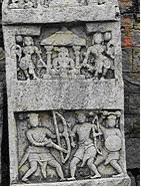Ferdinand Kittel (1832–1903), Christian missionary and Kannada writer
The nascent beginnings of modern Kannada literature can be traced to the early 19th c
.jpg) entury when King Krishnaraja Wodeyar III and his court poets attempted to steer away from the ancient champu form of prose and popularise prose renderings of Sanskrit epics and plays. Kempu Narayana's Mudramanjusha ("Seal Casket", 1823) can be considered as the first modern novel before English influence on Kannada.
entury when King Krishnaraja Wodeyar III and his court poets attempted to steer away from the ancient champu form of prose and popularise prose renderings of Sanskrit epics and plays. Kempu Narayana's Mudramanjusha ("Seal Casket", 1823) can be considered as the first modern novel before English influence on Kannada.The impetus to modern literature also came from the onset of western style of education and the Christian missionaries who relied on the local language to propagate their gospel. The arrival of the printing press acted as a catalyst in this process. Among the several early Kannada publications, the first Kannada-English dictionary by Ferdinand Kittel (1894) is noteworthy. Another prominent Christian missionary, Hermann Mögling, was responsible for publishing Kannada classics under a series called Bibliotheca Carnataca during 1848–1853 and the first-ever Kannada newspaper called Mangalore Samachara in 1843.
In the latter half of the 19th century, progress towards original works in prose narratives initially gained momentum through translations, mostly from Sanskrit and English. With the standardisation of modern prose, the earliest original social fictions were Suryakantha by Lakshman Gadagkar (1892) and Indira Bai by Gulvadi Venkata Rao (1899). The latter work critically examines social issues, reflecting an awakening to the need for social reform.
At the turn of the century, B. M. Srikantaiah ('B. M. Sri'), regarded by some as the "Father of modern Kannada literature", gave the call for writing original works in modern Kannada, stressing on moving away from old Kannada and for drawing from contemporary English literature. This period can be considered a seed time, for a golden age to come. Srikantaiah's adaptation of lyrics from English were effective, the best known among his works being the English Geethagalu ("English Songs"), a seminal work that set the trend for the Navodaya (new birth) style of Kannada poetry. Another prominent writer, Masti Venkatesh Iyengar, is credited with laying the foundation for a generation of short-story tellers with his Kelavu Sanna Kathegalu ("A few Short Stories", 1920) and Sanna Kathegalu ("Short Stories", 1924).
The consolidation of modern drama was pioneered by T.P. Kailasam, a towering personality in the field, with his Tollu Gatti ("The Hollow and the Solid", 1918). In contrast to the earlier Indira Bai (1899), this work examines the modern education system from a Gandhian viewpoint. Kailasam followed this with Tali Kattoke Cooline ("Wages for tying the Mangalsutra"), a critic on the dowry system in marriage. His plays were mainly concerned with problems affecting middle class Brahmin families: the dowry system, religious persecution, woes in the extended family system and exploitation of women. He was among the first ones in Kannada theatre to speak about liberal values, and is thus considered by some as the one who laid the foundation of amateur Kannada theatre.






